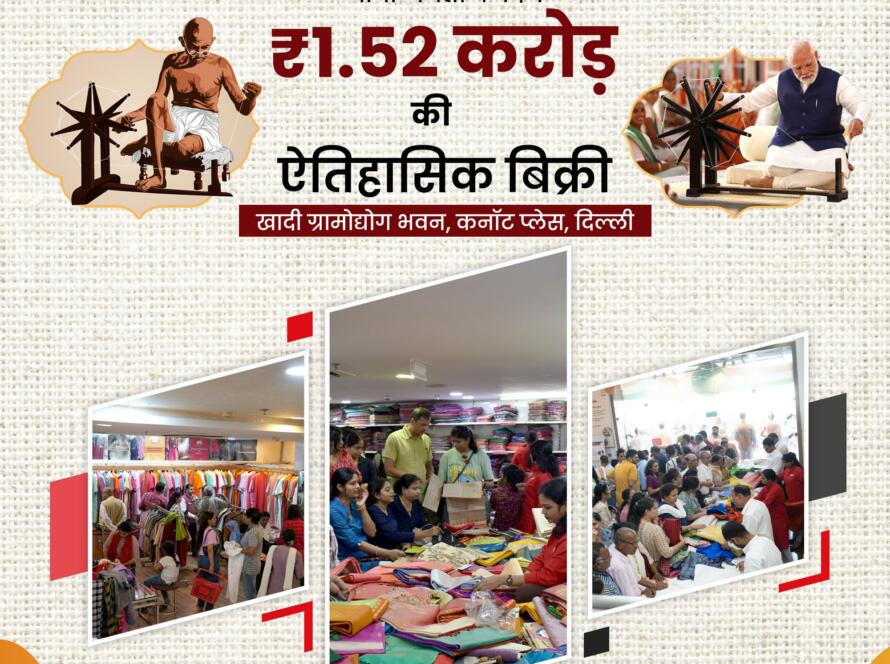In a significant step towards fostering women-led development and entrepreneurship, NITI Aayog’s Women Entrepreneurship Platform (WEP) initiated the NITI Aayog State Workshop Series with its inaugural event held in the picturesque state of Goa on October 3.
The workshop, held in collaboration with the Goa government, brought together a diverse array of stakeholders, including women entrepreneurs, local self-help groups (SHGs) and clusters, government officials, industry representatives, incubators/accelerators, financial institutions, philanthropic foundations, and more.
The workshop’s theme, “Enabling Women-led Development through Entrepreneurship,” underscored the critical role that women entrepreneurs play in driving economic growth and empowerment. The WEP, incubated within NITI Aayog, is a public-private partnership platform that serves as a valuable resource for women entrepreneurs. It provides essential information, facilitates connections through the SmartMatch feature, offers a supportive community page, and includes a mentorship module.
NITI Aayog and Women Entrepreneurship Platform Collaborate for Women-Led Development in Goa Workshop
Key dignitaries present at the event included Dr. Pramod Sawant, Chief Minister of Goa; V K Saraswat, Member of NITI Aayog; and BVR Subramanyam, CEO of NITI Aayog. During the workshop, the focus was on deliberating a “hub-and-spoke” model that aims to take women-led development to grassroots levels, ensuring that the benefits reach the last mile.
Dr. Pramod Sawant announced a significant development during the event—the preparation of the Goa State Vision 2047 with the assistance of NITI Aayog. He emphasized the renewed focus on skill development and the deployment of “Swayampurna Grameen Mitras” for doorstep delivery of government services in every block and panchayat. He also announced the launch of the “Swayampurna e-bazaar” during the Dussehra festival, which is expected to enhance market access through Common Service Centres, empowering local women entrepreneurs.
NITI Aayog CEO B V R Subrahmanyam reiterated the central government’s unwavering commitment to women-led development. He emphasized NITI Aayog’s role in assisting state governments in establishing similar institutions to promote entrepreneurship and development in each state.
The workshop saw several noteworthy collaborations announced to support women entrepreneurs. These collaborations include the partnership between the Institute of Chartered Accountants of India (ICAI) and NITI Aayog, the launch of “Udyam Uplift” by CAxpert—an initiative aimed at strengthening compliance among women-led businesses, and the launch of the first two cohorts under WEP’s “Award to Reward” (ATR) initiative. The ATR initiative aims to provide support and recognition to promising women entrepreneurs.
Throughout the day, participants engaged in panel discussions, fireside chats, and in-depth discussions on topics critical to the growth and success of women-led businesses, such as policy ecosystems for startup growth, access to finance and compliance, and strategies to make women entrepreneurs market-ready.
The inaugural NITI Aayog State Workshop Series in Goa served as a catalyst for empowering women entrepreneurs and fostering their essential role in India’s socio-economic development. It reinforced the commitment of NITI Aayog and the Goa government to create an ecosystem conducive to women-led businesses, ensuring that their contributions are recognized, supported, and celebrated.
FAQ
1. What is the Women Entrepreneurship Platform (WEP) and its role in women-led development?
The Women Entrepreneurship Platform (WEP) is an initiative incubated within NITI Aayog that aims to empower women entrepreneurs in India. It serves as a public-private partnership platform that provides information, connects women entrepreneurs with resources and opportunities, and offers mentorship and support. WEP plays a crucial role in fostering women-led development by promoting entrepreneurship among women.
2. What was the focus of the recent NITI Aayog State Workshop in Goa?
The workshop in Goa, organized by NITI Aayog and WEP, centered on the theme of “Enabling Women-led Development through Entrepreneurship.” It aimed to discuss strategies and initiatives to empower women entrepreneurs and promote their active participation in economic growth and development.
3. Who were the key participants at the Goa workshop?
The workshop brought together a diverse group of stakeholders, including women entrepreneurs, local self-help groups (SHGs), government officials, industry representatives, incubators/accelerators, financial institutions, philanthropic foundations, and more. Key dignitaries, including the Chief Minister of Goa and NITI Aayog officials, also attended.
4. How does the “hub-and-spoke” model discussed in the workshop work?
The “hub-and-spoke” model aims to take women-led development to grassroots levels. It involves establishing central hubs that serve as resources and support centers, with spokes extending to local communities. The goal is to ensure that the benefits of women-led development reach the last mile, empowering women at all levels.
5. What role does NITI Aayog play in supporting women-led development in India?
NITI Aayog is committed to promoting women-led development and entrepreneurship. It assists state governments in establishing institutions similar to WEP to foster entrepreneurship and development. It also collaborates with various stakeholders to create an ecosystem conducive to women-led businesses.
6. What are the initiatives launched during the workshop to support women entrepreneurs?
Several initiatives were announced during the workshop, including partnerships with the Institute of Chartered Accountants of India (ICAI) and the launch of “Udyam Uplift” to strengthen compliance among women-led businesses. The workshop also marked the launch of the first two cohorts under WEP’s “Award to Reward” (ATR) initiative.
7. What is the significance of the Goa State Vision 2047 announced during the event?
The Goa State Vision 2047, prepared with the assistance of NITI Aayog, is a long-term plan for the state’s development. It reflects the commitment to a holistic approach to socio-economic progress, encompassing skill development and enhanced accessibility of government services.
8. How does the “Swayampurna e-bazaar” initiative aim to empower women entrepreneurs?
The “Swayampurna e-bazaar” initiative, announced during the workshop, aims to expand market access for women entrepreneurs through Common Service Centres. It facilitates the online sale of products and services, enabling women entrepreneurs to reach a broader audience.
9. What were the key topics discussed during the panel discussions at the workshop?
Panel discussions at the workshop covered critical topics such as harnessing policy ecosystems for startup growth, promoting access to finance and compliance, and strategies to make women entrepreneurs market-ready.
10. How can women entrepreneurs benefit from the mentorship module offered by WEP?
WEP’s mentorship module provides women entrepreneurs with access to experienced mentors who can offer guidance, support, and valuable insights. It enables mentees to navigate challenges, make informed decisions, and grow their businesses effectively.
11. How can women entrepreneurs access government schemes through WEP’s SmartMatch feature?
WEP’s SmartMatch feature connects women entrepreneurs with relevant government schemes and initiatives. It simplifies the process of accessing government support, ensuring that eligible entrepreneurs can benefit from these programs.
12. What is the role of local self-help groups (SHGs) and clusters in women-led development?
Local SHGs and clusters play a vital role in fostering entrepreneurship among women. They provide a platform for women to collaborate, share resources, and collectively engage in economic activities, thereby contributing to women-led development.
13. How can industry representatives contribute to women-led development?
Industry representatives can support women-led development by offering mentorship, creating opportunities for women entrepreneurs to collaborate, and advocating for gender-inclusive policies and practices within their sectors.
14. How does WEP’s community page facilitate networking among women entrepreneurs?
WEP’s community page serves as a virtual space for women entrepreneurs to connect, share experiences, seek advice, and collaborate. It fosters a sense of community and solidarity among women in business.
15. What is the significance of the “Award to Reward” (ATR) initiative under WEP?
The ATR initiative under WEP aims to recognize and support promising women entrepreneurs. It provides them with opportunities, resources, and mentorship to scale their businesses and make a significant impact.
16. How does the “Udyam Uplift” initiative strengthen compliance among women-led businesses?
“Udyam Uplift,” launched in collaboration with CAxpert, focuses on enhancing compliance among women-led businesses. It provides them with guidance and resources to meet regulatory requirements, ensuring their sustainability and growth.
17. What is the goal of the “Swayampurna Grameen Mitras” initiative mentioned by the Chief Minister of Goa?
The “Swayampurna Grameen Mitras” initiative aims to provide doorstep delivery of government services in every block and panchayat. It simplifies access to essential services and supports socio-economic development in rural areas.
18. How does NITI Aayog plan to assist state governments in promoting entrepreneurship and development?
NITI Aayog is committed to assisting state governments in setting up institutions similar to itself to promote entrepreneurship and development. This support includes sharing best practices and providing guidance.
19. What are the expectations for the future of women-led development in India?
The future of women-led development in India is promising, with increased recognition of the crucial role women entrepreneurs play in the country’s economic growth. Initiatives like WEP and collaborative efforts are expected to further empower women in entrepreneurship.
20. How can women entrepreneurs get involved with the initiatives discussed at the workshop?
Women entrepreneurs can get involved by exploring the resources and opportunities offered by WEP, participating in relevant programs, and staying informed about upcoming initiatives and collaborations in the field of women-led development.






